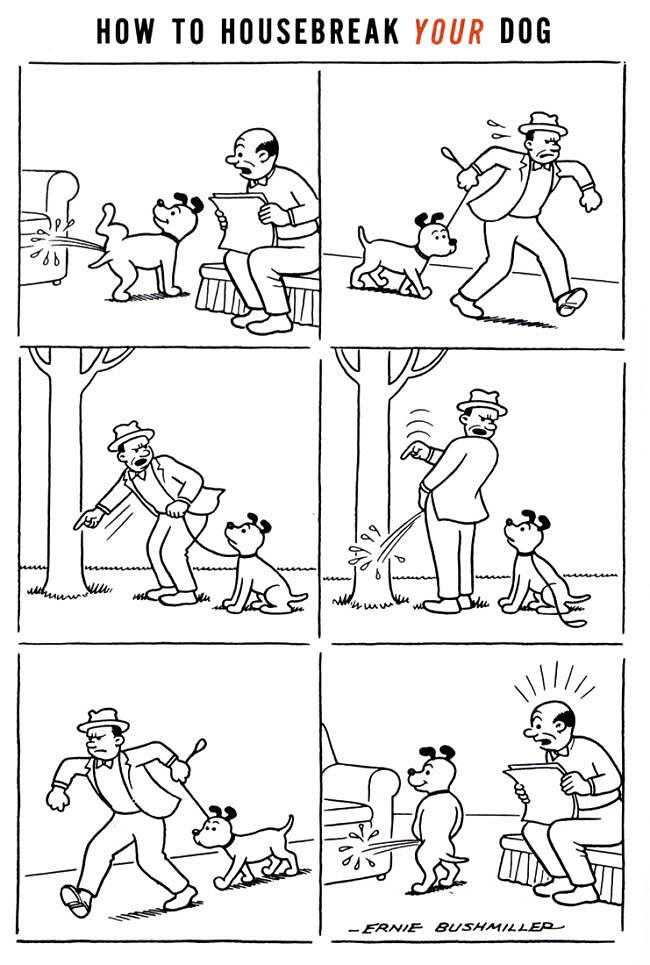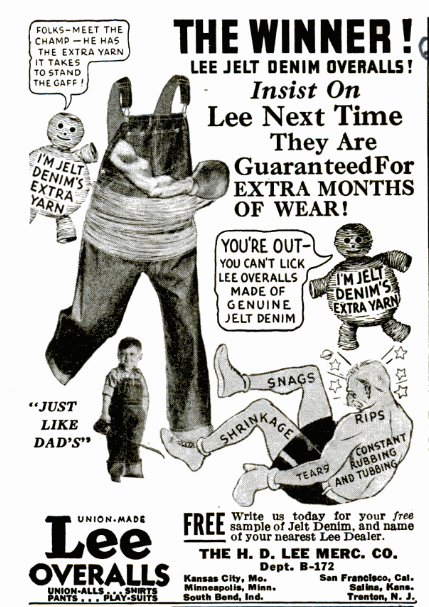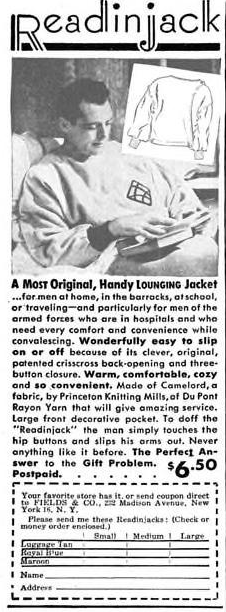July 2019
July 6, 2019
How to housebreak your dog
Ernie Bushmiller is best known as the creator of the Nancy comic strip, which was known for being very wholesome. But it turns out that his most popular and frequently reproduced cartoon, by a wide margin, was a slightly off-color one that he drew in 1961, and which was included that year in the Duch Treat Club Yearbook. He titled it "How to housebreak your dog."The Comics Journal details the many lives of this cartoon, noting:

Posted By: Alex - Sat Jul 06, 2019 -
Comments (3)
Category: Comics, Dogs, 1960s
Follies of the Madmen #432

Posted By: Paul - Sat Jul 06, 2019 -
Comments (1)
Category: Anthropomorphism, Business, Advertising, Fashion, 1930s
July 5, 2019
Did Jesus Poop?
It's one of the more perplexing questions in Christian theology. A recent article in The Daily Beast explains why, over the centuries, the issue has kept rearing its head:There's also a book, published in 2018, with that title (amazon link). I have no idea of its quality (never having read it), but sometimes a title alone can be worth the price of purchase. For instance, the book sounds perfect to include among the reading material in a guest bathroom.

Posted By: Alex - Fri Jul 05, 2019 -
Comments (5)
Category: Religion, Books, Excrement
The Man Called Flintstone
Fred Flintstone as James Bond. Nuff said!The Wikipedia page.
Posted By: Paul - Fri Jul 05, 2019 -
Comments (0)
Category: Spies and Secret Agents, Homages, Pastiches, Tributes and Borrowings, Cartoons, 1960s
July 4, 2019
Happy 4th of July 2019!
Be safe!
Posted By: Paul - Thu Jul 04, 2019 -
Comments (1)
Category: Fireworks and Pyrotechnics, Holidays
Curry-Covered Seagulls
Mike in the UK gave us a heads up about a curious case of weird-news déjà vu.A few weeks ago news outlets reported that a seagull had turned bright orange after apparently falling into a vat of curry. But rewind to 2016, and an almost identical incident occurred when a seagull turned bright orange after falling into a container of chicken tikka masala "while trying to scavenge a piece of meat from a food factory bin."
And I've managed to find a third incident, that also happened in 2016, involving a seagull in Newport, south Wales that fell into a vat of tandoori sauce.
So how often exactly do seagulls fall into vats of curry? Are there even more cases out there?
The 2016 incident
Posted By: Alex - Thu Jul 04, 2019 -
Comments (1)
Category: Animals, Food
July 3, 2019
Blue Snow
One of the more bizarre consequences of the atmospheric nuclear tests of the 1950s was that, hundreds of miles away, radioactive blue snow began to fall.Traveling salesman M.C. Myer was one of the first to report seeing this phenomenon in 1953, while driving through Shasta County, California:

Los Angeles Times - Apr 10, 1953

St. Louis Post Dispatch - Aug 7, 1994
Posted By: Alex - Wed Jul 03, 2019 -
Comments (3)
Category: Atomic Power and Other Nuclear Matters, 1950s
Follies of the Madmen #431

Has this fellow decided to masochistically shame himself by creating this pitchfork doppelganger? Or did the local bad boys construct it and leave it on his lawn, and he is now gazing at it ruefully, realizing the veracity of their taunt? Or thinking, "There, but for the grace of Vitalis, go I."
Source.
Posted By: Paul - Wed Jul 03, 2019 -
Comments (4)
Category: Business, Advertising, 1950s, Hair and Hairstyling
July 2, 2019
B. Prosperous
Continuing our ongoing theme of strange corporate mascots:From 1960-1962, B. Prosperous was the mascot of the Eastern Trust Company. He demonstrates a popular trend among mid-twentieth-century mascot creators, which was to slap a human head and limbs onto some inanimate object and call it a mascot.

Montreal Gazette - Mar 22, 1961
Posted By: Alex - Tue Jul 02, 2019 -
Comments (2)
Category: Corporate Mascots, Icons and Spokesbeings, 1960s
The Readinjack

The ad copy is unique.
Source.
Posted By: Paul - Tue Jul 02, 2019 -
Comments (3)
Category: Fashion, Advertising, Chindogu, 1940s
| Get WU Posts by Email | |
|---|---|

| Who We Are |
|---|
| Alex Boese Alex is the creator and curator of the Museum of Hoaxes. He's also the author of various weird, non-fiction books such as Elephants on Acid. Paul Di Filippo Paul has been paid to put weird ideas into fictional form for over thirty years, in his career as a noted science fiction writer. He has recently begun blogging on many curious topics with three fellow writers at The Inferior 4+1. Chuck Shepherd Chuck is the purveyor of News of the Weird, the syndicated column which for decades has set the gold-standard for reporting on oddities and the bizarre. Our banner was drawn by the legendary underground cartoonist Rick Altergott. Contact Us |

